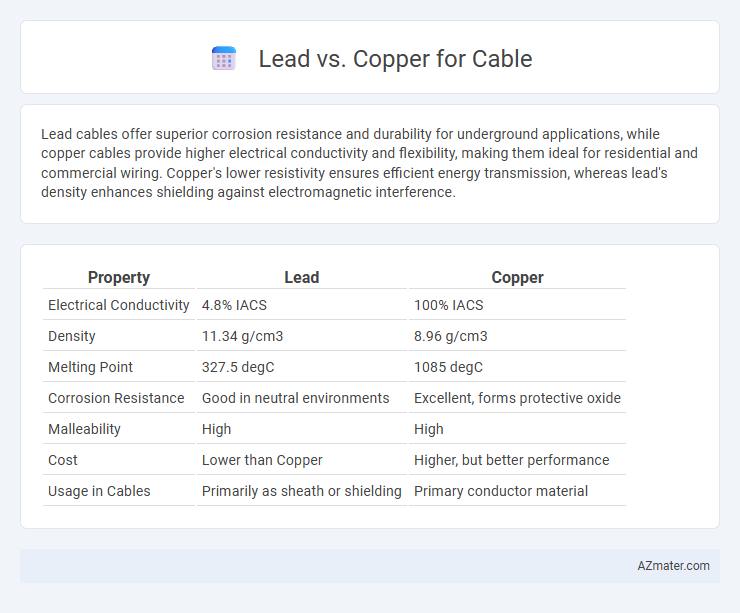Lead cables offer superior corrosion resistance and durability for underground applications, while copper cables provide higher electrical conductivity and flexibility, making them ideal for residential and commercial wiring. Copper's lower resistivity ensures efficient energy transmission, whereas lead's density enhances shielding against electromagnetic interference.
Table of Comparison
| Property | Lead | Copper |
|---|---|---|
| Electrical Conductivity | 4.8% IACS | 100% IACS |
| Density | 11.34 g/cm3 | 8.96 g/cm3 |
| Melting Point | 327.5 degC | 1085 degC |
| Corrosion Resistance | Good in neutral environments | Excellent, forms protective oxide |
| Malleability | High | High |
| Cost | Lower than Copper | Higher, but better performance |
| Usage in Cables | Primarily as sheath or shielding | Primary conductor material |
Introduction to Lead and Copper in Cable Manufacturing
Lead and copper are essential materials in cable manufacturing due to their distinct electrical and physical properties. Copper is widely used for its excellent electrical conductivity, flexibility, and durability, making it ideal for power and communication cables. Lead, although less conductive, is primarily employed as a protective sheath in cables to provide moisture resistance and corrosion protection, enhancing cable longevity in harsh environments.
Historical Overview of Lead and Copper Usage
Copper has been historically favored for electrical cables due to its excellent conductivity and ductility, dating back to ancient civilizations using it for wiring and plumbing. Lead, while less conductive, gained usage primarily for cable sheathing and protection because of its corrosion resistance and malleability, especially in early telecommunications and power distribution networks. Over time, copper's superior electrical properties have ensured its dominance in cable manufacturing, although lead remains important for protective applications in specific environments.
Electrical Conductivity: Lead vs Copper
Copper offers significantly higher electrical conductivity than lead, making it the preferred choice for electrical cables and wiring. Copper's conductivity is approximately 5.96 x 10^7 S/m, whereas lead's conductivity is much lower, around 4.8 x 10^6 S/m, which results in greater energy efficiency and less power loss. The superior conductivity of copper enables it to carry higher current loads with minimal resistance, improving overall performance and reliability in electrical systems.
Mechanical Properties and Durability
Copper cables exhibit superior mechanical properties compared to lead cables, including higher tensile strength and better flexibility, making them less prone to damage under stress. The durability of copper cables is enhanced by their excellent resistance to corrosion and fatigue, ensuring long-term reliability in various environmental conditions. Lead cables, while offering good malleability and initial protection against moisture, tend to degrade faster due to lower mechanical strength and susceptibility to cracking under mechanical strain.
Corrosion Resistance Comparison
Copper exhibits superior corrosion resistance in cable applications due to its stable oxide layer that prevents further degradation, making it ideal for long-term use in various environments. Lead, while resistant to some corrosive elements, tends to oxidize and form a less protective surface, leading to faster deterioration under harsh conditions. Choosing copper cables ensures enhanced durability and minimal maintenance costs compared to lead, especially in outdoor or industrial settings.
Safety and Environmental Considerations
Lead cables pose significant safety risks due to lead's toxicity, which can cause severe health issues through prolonged exposure or improper handling. Copper cables offer a safer alternative, being non-toxic and widely recyclable, which minimizes environmental impact and supports sustainability efforts. Copper's superior conductivity and durability further enhance its environmental benefits by requiring less material and energy over the cable's lifespan.
Cost Analysis: Lead vs Copper Cables
Lead cables generally have higher initial material costs compared to copper cables due to lead's density and specialized manufacturing processes. Copper cables offer better conductivity and durability, resulting in lower long-term operational costs despite their moderate upfront price. Cost analysis favors copper cables for most electrical applications because of their efficiency and longer lifespan, offsetting their steady market price volatility.
Common Applications in Various Industries
Lead cables are predominantly used in underground and mining applications due to their excellent corrosion resistance and durability in harsh environments. Copper cables, favored in telecommunications, electrical wiring, and power distribution, provide superior conductivity and flexibility, making them ideal for efficient energy transmission. Industries such as construction and automotive rely heavily on copper cables for their strength and reliability in both indoor and outdoor installations.
Installation and Maintenance Differences
Lead cables offer superior corrosion resistance, making them ideal for underground or moist installations, while copper cables provide excellent electrical conductivity and flexibility for easier handling during installation. Maintenance of lead cables typically requires less frequent attention due to their durability, whereas copper cables may need more regular inspections to prevent oxidation and ensure optimal performance. The weight of lead cables can complicate installation compared to lighter copper alternatives, affecting labor costs and time.
Future Trends in Cable Material Selection
Future trends in cable material selection emphasize the shift from traditional lead sheathing to copper due to copper's superior electrical conductivity, corrosion resistance, and environmental sustainability. Advances in copper alloy development and eco-friendly manufacturing processes enhance cable durability and performance, aligning with increasing regulatory demands for safer, recyclable materials. The rise of smart grids, renewable energy integration, and electric vehicle infrastructure further drive the preference for copper cables to support higher efficiency and reduced energy losses.

Infographic: Lead vs Copper for Cable
 azmater.com
azmater.com